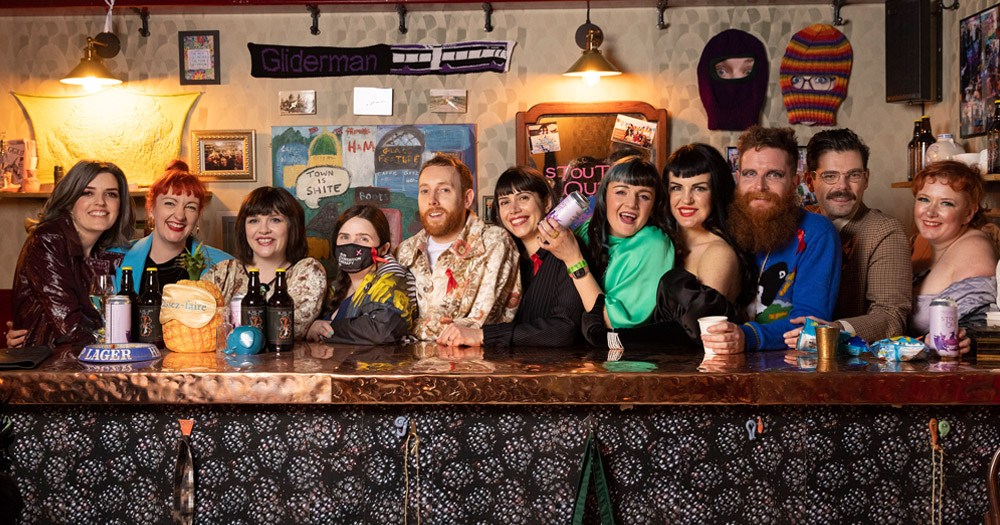The UK’s Turner Prize is one of the most prestigious arts awards and is coveted by artists on both sides of the Irish Sea. Following controversy over the decision to award the 2020 prize to all the short-listed entries, the 2021 Turner Prize made the decision to only nominate artist collectives, garnering yet more debate. We’ll leave it up to others to draw their own conclusion on that, we’re just over the moon that the award went to the amazing Array Collective from Belfast.
We were delighted to have a sit down with two of the members of Array Collective, Emma Campbell and Thomas Wells along with two of the fabulous contributing artists, Richard O’Leary and Patrick Scullion (aka drag persona, Rosa Tralee).
Can you tell us a bit about how the Array Collective came about?
Emma: “We didn’t sit down and write a manifesto to decide to be a collective, it was more like a lot of us were friends already and then a lot of us turned up to the same protests. But also there is a physical studio, so six of us are members of there as well. I suppose we really came together organically around the same kind of political concerns or political outlook, but also, I would say as well, a very similar sense of daft humour.
We’ve tried to maintain our own identity as not just people who are kind of socially engaged, but people who we feel comfortable with being silly and absurd with as well.”
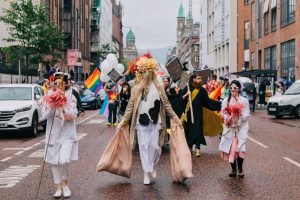
You mention that Array came together as a collective because of mutual social and political interests, such as through meeting at the same rallies. Are social issues a core tenet of Array’s work?
Thomas: “I think that we all have – I don’t know if it would be a shared interest – but a shared position on a lot of social and human rights that hadn’t been afforded to us for so many years. I think being members of the LGBT community in Belfast – especially [for me] being an English man coming over to Northern Ireland, in the past four years and not being afforded the same rights that were afforded to me in the place that I was born – I think in that sense, they weren’t core tenets of the collective but they were things that we were out demonstrating about because we were affected by them.
But in no way did we start this and, unfortunately, I don’t think we’ll finish it. I think it’s down to generations of activism that has been there before us and led the way.”
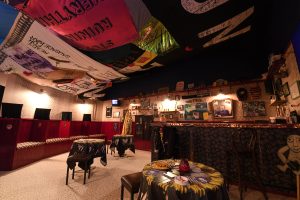
Richard: “My storytelling is known to be entertaining, but for me, it’s not primarily about entertainment. Yes, I want the audience to enjoy themselves but I’m an activist and life is short, and there are very important issues to be addressed. And I’m going to make sure that the audience learns something from the storytelling experience. So for me, art and activism are intrinsically linked. And that is also connected to enjoying ourselves in what’s an otherwise serious business of political activism.
As part of Array’s installation for the Turner Prize, you held an event in the Black Box in Belfast called the ‘Druthaid’s Ball’ which you then projected in the síbín that you created in the Herbert Gallery in Coventry. Can you explain a bit about the Ball?
Thomas: “I think it came about, or one of the reasons it came about, was obviously we were in a centenary year, in the North of Ireland, or in Ireland, and we wanted to – I think the plans of celebrations around that were things that we didn’t align with or we didn’t identify with. I think that we wanted to bring this kind of tongue-in-cheek-ness to it. We wanted to criticise that a little bit in a way. And as the feeling was of celebration, we wanted to wake it in some way. So both mourn it and also celebrate it in a different way. So this is why we came up with the idea of waking the centenary.
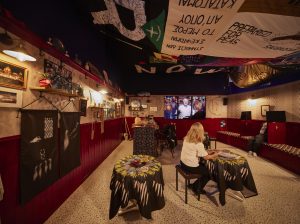
Emma: “We also knew that very few people from the North would be able to get over to Coventry to see a Turner Prize show. We’d already shown in London and we already knew the exclusive nature of having something in a particular place that means only certain people can physically access it. So part of the reason for having the Ball is the idea that we talked about at the start, of inclusivity, of including the rest of the arts and activist community in Belfast, and a way to do that was to include them in work, as part of the work. Right from the start that was a conscious decision.
Then once we made the film, we also showed it again to the guests and artists because we knew the majority of them aren’t going to get over to Coventry. And this was really like a slightly bittersweet love letter to Belfast as well.”
View this post on Instagram
Patrick, similarly, a contemporary drag queen doesn’t seem to really fit the notion of the pagan druids but again, your performance works really well in that context. So how did that come about?
Patrick: “Emma and Clodagh, who’s another member of Array, approached me knowing of my reputation as a local headbanger, which would be a far greater part of my practice than necessarily the drag part or any other part of the thing. You can just always assume I’m going to do something a bit mental, a bit unwise.
“I liked this idea of doing a wake slash celebration. A friend of mine called Sophie Williams, who was an activist and an artist in Belfast, who moved to London in 2020, she passed away in May this year [2021]. And she was a true, true gag and she was someone who really, really wanted to win the Turner Prize.
“That was a girl who really, really would have wanted that for herself and I don’t think she would mind me saying that. She really wanted to be famous in a way that she was quite proud of how inelegant her desire for that was. And she also loved Belfast, she loved Northern Ireland, in the way of – she loved our particular fetish for local celebrity.
“She really really loved that – And that is something that’s very particular about Ireland, but especially Northern Ireland. She loved local celebrities and in Belfast, a local celebrity is far bigger than a real celebrity like Adele – I work in a shop and if Adele came in, it wouldn’t be as big news as if May McFetridge, the local pantomime dame came in.
View this post on Instagram
“I say that because I wanted to do a story that was about the mourning of a local celebrity. So I wrote this piece and to me the drag elements of it are sort of incidental to the impulse to create a little mini world and everything in it. I like to create a whole little set. And this is everything, and everything’s a bit drag, though, maybe the drag extends beyond just what I look like into. And this is a dragged up version of that thing we’re all talking about.”
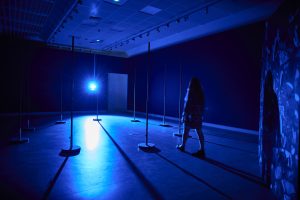
So how did you go from the idea of the ‘Druthaid’s Ball’ to bringing it into a síbín for the installation?
Thomas: “I suppose structurally the idea came from research that we were doing in ancient pre-Christian sites. So we were kind of interested in circular spaces, and the circular space as an important mystical site, but also the duality between the two. That’s why for the installation there is a partially circular síbín and also these circular flag poles outside of the space.
“The actual idea of the síbín is very much part of that journey of the rally or the journey through the process. It’s where a lot of protests through history have been organised, it’s where groups have organised, groups have met. But then also, for us, it was definitely the place where we would go after, and one in particular in Belfast, the Sunflower, which, you know, has got a really interesting history of its own but it’s a queer space, it’s a safe space.
“And it’s very much just that space for us, where after the Saturday rally, whether it be for International Women’s Day or Alliance for Choice, or marriage equality, we would all go there. And that’s where we would discuss and then organise the next one, and just really play off each other. I think that that was really important. We wanted to create that space within the journey of walking through the exhibition.”
Emma: “We also had, from the Jerwood [Arts Space] exhibition that we had in London before, we three central characters, the Bomby, the Long Shadow and the Margan. And the Long Shadow, one of those characters, is really about generational trauma, and shared community grief. And the Irish diaspora over in England, or wherever really, and the pub obviously looms large in the story of the narrative of the Irish diaspora. And it is a stereotype, and it feeds into a certain Irish stereotype, but we felt like it was an important one to deal with. Why are we so connected to these drinking spaces and alcohol and all that kind of thing?
View this post on Instagram
“And so the Long Shadow and all those three characters then came with us into the Turner and we just increased the Pantheon to a larger number, to nine. But the síbín is is a place for remembrance and memory and gathering and storytelling, and a place for mourning as well.
“Also, it had to be a síbín because it is about imperialism, and it is about colonialism, and it is about the fact that these spaces had to be made for communities because things like Penal Laws or licencing laws, things that never existed until there were British people on the island. So that was all really kind of feeding into it.”
Thomas: “And the irony being that the major British press have picked up on the reviews of this and just took the idea of the síbín and gone ‘Oh, it’s a pub. Oh, they’re Irish. Oh, hilarious’. Whereas, there’s an amazing article by Jane Morrow and Ciara Hickey in Elephant that just really picks that apart.”

What does winning the Turner Prize mean to you both on a personal level and for Array as a collective?
Emma: “We just want to make sure that whatever gains or whatever traction that we get from winning, is that ripples bigger than us. It’s about the whole arts community in Belfast but with the bonus of an open-top bus ride through Belfast. And we are planning to bring it to different places and then eventually end up in Belfast, but we think probably the next place will be Galway. We think it might be read differently because there is still problematic relationships, obviously North and South as well. But we really didn’t expect to be the winners, so yeah.”
Thomas: “We really didn’t and I think that says quite a lot about the arts in Ireland and in the North of Ireland as well. The fact that we even got nominated was something that hit. Like, you know, it’s stuff that you hear about art college and it’s the thing that you think immediately goes to like Tracy Emin and it’s mad that we’re part of this canonical structure. Like we are so anti canon, it’s unbelievable.
“But personally, it’s amazing – I think that we all went back to work the next day – we all went back to our children, to our families, like it’s funny. I’ve just started a new job at the National Museum and I went in on my first day and everyone was like, ‘Oh, congratulations’ and I swear to God, I just thought they meant congratulations on the job. I’m so happy, a full-time job is amazing to have as an artist, that’s kind of rare. But also, my family now know what I do!”
Emma: “Exactly! I was going to say – For loads of us, it’s like, finally our families are like, ‘Oh, right, so this art stuff is actually great’.”
© 2022 GCN (Gay Community News). All rights reserved.
Support GCN
GCN is a free, vital resource for Ireland’s LGBTQ+ community since 1988.
GCN is a trading name of National LGBT Federation CLG, a registered charity - Charity Number: 20034580.
GCN relies on the generous support of the community and allies to sustain the crucial work that we do. Producing GCN is costly, and, in an industry which has been hugely impacted by rising costs, we need your support to help sustain and grow this vital resource.
Supporting GCN for as little as €1.99 per month will help us continue our work as Ireland’s free, independent LGBTQ+ media.
